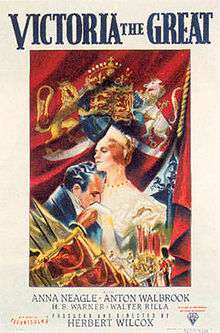Victoria the Great
| Victoria the Great | |
|---|---|
 | |
| Directed by | Herbert Wilcox |
| Produced by | Herbert Wilcox |
| Written by |
Miles Malleson Charles de Grandcourt |
| Starring |
Anna Neagle Anton Walbrook Walter Rilla H.B. Warner Mary Morris |
| Music by | Anthony Collins |
| Cinematography |
William V. Skall Freddie Young |
| Edited by | Jill Irving |
| Distributed by | RKO Radio Pictures |
Release dates |
|
Running time | 112 min |
| Country | United Kingdom |
| Language | English |
Victoria the Great is a 1937 British historical film directed by Herbert Wilcox and starring Anna Neagle, Anton Walbrook and Walter Rilla.[2] When Laurence Housman's play Victoria Regina was banned by the Lord Chamberlain (in 1935, the Royals could not be shown on the British stage); its subsequent Broadway success prompted King Edward VIII to commission producer Herbert Wilcox to turn it into a film, commemorating the centenary of Victoria's reign.[3] The film biography of Queen Victoria concentrates initially on the early years of her reign with her marriage to Prince Albert and her subsequent rule after Albert's death in 1861. It was released in the year of King George VI's coronation, which was also the centennial of Victoria's own accession to the throne. The movie was so successful that a sequel appeared the following year, Sixty Glorious Years.[4]
Main cast
- Anna Neagle as Queen Victoria
- Anton Walbrook as Prince Albert
- Walter Rilla as Prince Ernest
- H.B. Warner as Lord Melbourne
- Mary Morris as Duchess of Kent
- James Dale as Duke of Wellington
- Felix Aylmer as Lord Palmerston
- Charles Carson as Sir Robert Peel
- Gordon McLeod as John Brown
- C.V. France as Archbishop of Canterbury
- Arthur Young as William Gladstone
- Greta Schröder as Baroness Lehzen
- Paul Leyssac as Baron Stockmar
- Derrick De Marney as Younger Disraeli
- Hugh Miller as Older Disraeli
- Percy Parsons as President Abraham Lincoln
- Hubert Harben as Lord Conyngham
- Henry Hallett as Joseph Chamberlain
Critical reception
Variety wrote, "Not cloak-and-cocked-hat historical tedium of pageantry and fancy dramatics, Victoria the Great travels a long way toward a full and clarified explanation of the most popular ruler England ever had...Anna Neagle, in the title role, gives an unwavering performance throughout. Anton Walbrook as Albert, the Prince Consort, is superb...The film wisely puts its prime focus on the private life of Victoria, her romance, marriage, and personal characteristics. Backgrounded is her public life, and her gradual rise to such high estimation of her people. Victoria the Great is done with a lavish hand – the closing sequence is in Technicolor [shot by William V. Skall]. The tinting isn’t too good, but serves effectively as a pointer-up for the climax." ;[5] and more recently, the Radio Times wrote, "It's all fairly tame, and a long way from the rough ride given to the royals of today. Yet Neagle's sympathy for the monarch shines through, and the final reel, which bursts into glorious Technicolor for the Diamond Jubilee, is a delightful piece of patriotic pomp."[3]
References
- ↑ "Victoria the Great: Detail View". American Film Institute. Retrieved 11 April 2014.
- ↑ "Victoria the Great (1937)".
- 1 2 "Victoria the Great - Film from RadioTimes".
- ↑ "Victoria the Great (1937) - Notes - TCM.com".
- ↑ Staff, Variety (1 January 1937). "Review: 'Victoria the Great'".
Bibliography
- The Great British Films, pp39–41, Jerry Vermilye, 1978, Citadel Press, ISBN 0-8065-0661-X
External links
- Victoria the Great at the Internet Movie Database
- Victoria the Great at AllMovie
- Victoria the Great at the TCM Movie Database
- Victoria the Great at Virtual History